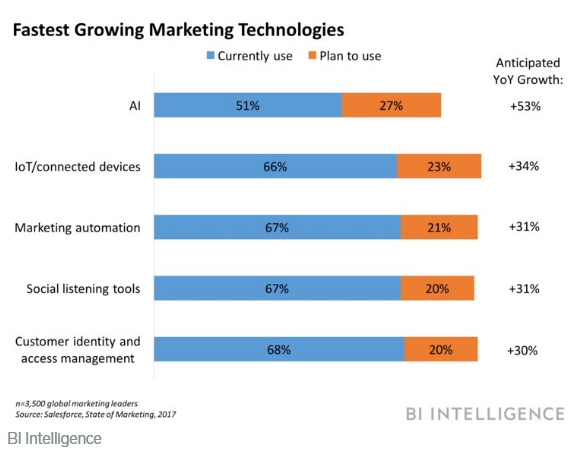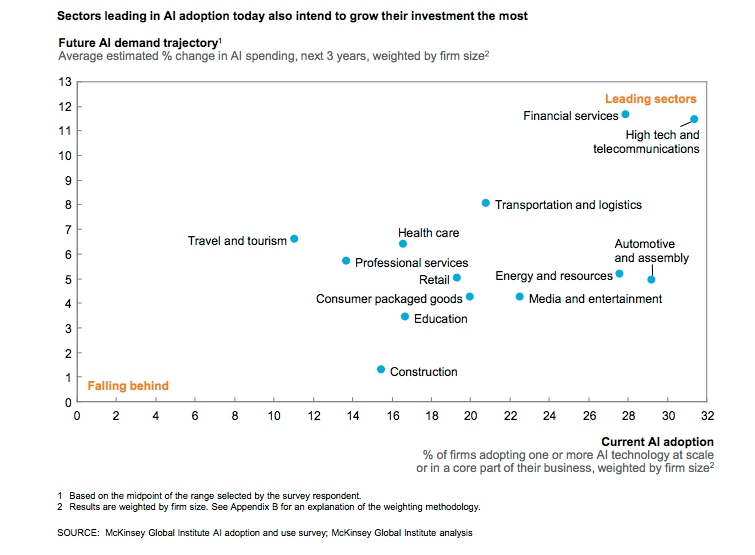Although the speed of AI adoption among consumers may be a bit lower than expected, it is already transforming the way they experience the world of customer service. The algorithms within the system, powered by ML software development solutions, are able to process the vast amounts of data created every instant and use it to make decisions on what is most likely to be appealing to different groups of consumers. As our contemporaries are getting used to this expanding world of seamless customer experiences, any business willing to keep up with the competition must rely on AI software development services to be part of this universe.
According to the report by Salesforce, over 51% of marketers currently use AI, while the additional 27% are planning to incorporate the technology by the next year. So far, it is the highest anticipated year-over-year growth percentage among any leading technologies that marketers expect to adopt in 2019. This way, as the volume of consumer-generated data is continually growing, techniques like machine learning, deep learning, and natural language processing (NLP) will become increasingly important to decision-making based on the use of data.

Below are the leading industries in terms of current AI adoption:

Isaac Sacolick, a former CIO who now advises CIOs on big initiatives like digital transformation summed up its fundamental principle: “This is the heartbeat of how you get experience in front of your users or employees or prospects, so they don’t have to do a lot of keyed entries.”
I’m positive you’re familiar with some of them:
- People You May Know (Facebook)
- Other Movies You May Enjoy (Netflix)
- Jobs You May Be Interested In (LinkedIn )
- Customer Who Bought This Item Also Bought … (Amazon )
- Visually Similar Images (Google)
- Recommended Videos (YouTube )
Recommendation engines (also known as recommender systems) gained attention thanks to the online retail/eCommerce industries. The most common usage is definitely the Amazon’s section on “Customer who bought this item also bought …” Generally speaking, a recommendation engine may be regarded as an intelligent and sophisticated sales person who knows the customer’s habits well: preferences, taste, and style. Based on this knowledge, it can make more intelligent decisions on recommendations that would benefit both a particular customer (reasonable advice) and a business itself (increased possibility of a conversion).
Being originally labelled “an eCommerce thing”, recommendation systems are now gaining popularity in other industries, most notably in Entertainment and Media. YouTube’s “Recommended Videos” or Netflix’ “Other Movies You May Enjoy” are among the most popular use cases. It’s worth noting that Netflix doesn’t just take into account what movies a person has watched – they’re also analyzing, which movies have been watched multiple times, rewound or fast-forwarded. These behavioral patterns, when correlated and assessed over millions of other users, help to draw out the most appropriate recommendations. In fact, it’s not about the industry: it’s all about data. “It could be an insurance form or a banking form, anything that has a lot of data entry in it and has the ability to use recommendation engines to make suggestions — and make it easier for people to fill things out,” commented Sacolick.
From the technical perspective, recommendation systems rely on algorithms that learn from previous data: preferred, liked or bought products by a particular customer or even by customers with similar behavior.
This way, a recommendation engine may be regarded as an excellent tool for proper filtering: customers only see relevant data according to their taste, style, and preferences. That’s why a good recommendation system should be able to continuously learn and adapt itself to a new user behavior. Secondly, it has to be supplied with fresh data in real time.
For example, a large (and updatable) list of special offers may turn accurate recommendations into obsolete info shortly after some changes have been made. Thus, a reliable recommendation engine must “learn” in a highly dynamic environment.
The dominant approaches in creating recommendation engines are:
Collaborative Filtering
Collaborative Filtering helps engines “understand” what users may like based on the articles and information two users like in common. In this case, the similarities are being defined by the behavior of the user/customers. This conduct serves as a basis for building stronger connections with every piece of content users share with each other and, consequently, may increase the chances of further engagement.
The flexibility is the key to keep up with a variety of requirements. A good recommendation system has to be scalable to process an increasing number of users and items and reflect seasonal or regional changes in real-time. The most popular methods of making recommendations are:
Content-Based Filtering
The similarities of the products are created in correlation to all available data, such as brand, price, description, color, and size. The content data of each article is regarded by the system as a set of descriptors, typically the words that occur in a document. The user profile is represented with the same terms and built up by analyzing the content of items, which have been seen by the user.
Hybrid Recommendation Systems
The following technique is the combination of the two methods listed above. As there is no need for a description of recommended items, the system can deal with any kind of information. Furthermore, the system is able to recommend items to users, which may have very different tastes from what they have shown before. Finally, because recommendations are based on the opinions of others, it is a perfect match for subjective domains like art markets.
Demographic-Based filtering
In this type of system, recommendations are based on customers’ demographic info. In this case, the system will suggest items that have been selected by other users fitting the same demographic profile. The benefit of a demographic approach is that it does not require a history of user ratings like that in collaborative and content-based systems.
Utility-Based filtering
This type of system is based on the value that the user will get from the product. The main advantage of using a utility-based approach lies in the processing of non-product attributes like vendor reliability and product availability. Utility-based recommendations systems are very precise in “calculating” this value for the user.
In a nutshell, a proper recommendation engine must provide:
- quicker and better business insights
- personalized and connected user experiences
- better round-the-clock customer service
- automated and personalized marketing campaigns
Sure enough, recommendation systems must evolve. At first sight, they may discourage non-technical marketing people as the math and analytics behind their creation are advanced even in its simple forms. However, that level of complexity should not be a red flag for marketers. “We believe that recommendations have much further to go, to model the relationship between a person and the products they use. Today ‘deep learning’ is beginning to let us find spaces where people and products coexist, where they have a relationship, although it might not be obvious by using immediate logic.” summarizes Juan Arévalo, Data scientist at BBVA Data & Analytics and expert in recommendation systems.









